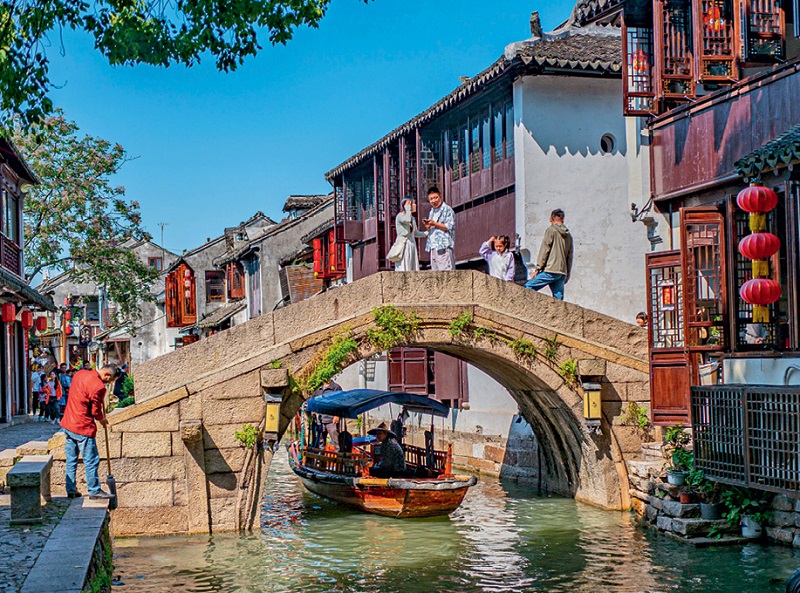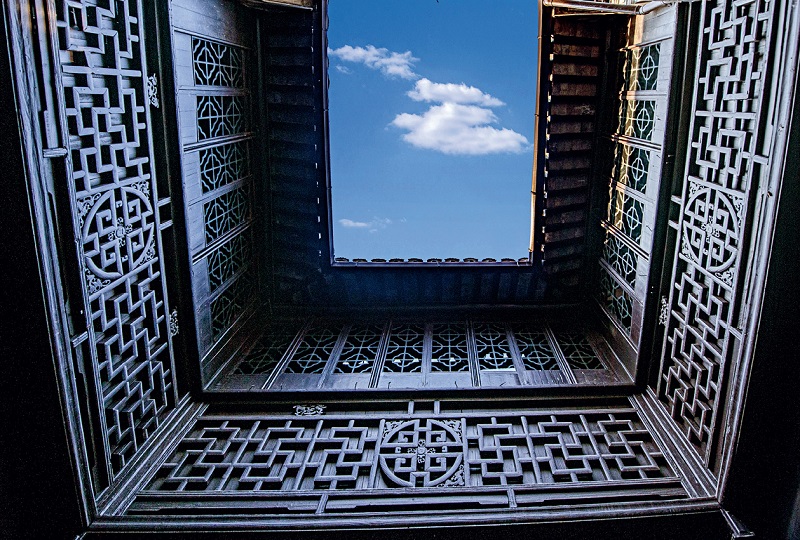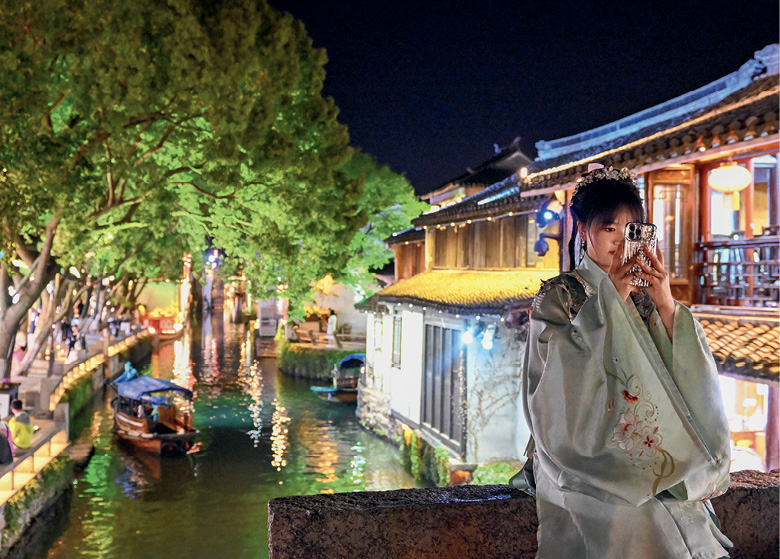Zhouzhuang is a well-preserved water town located in Kunshan City of east China’s Jiangsu Province, having a history of over 900 years. Age-old structures such as residential buildings, bridges, and temples as well as its unique rural landscape have made it one of the most-visited attractions in China and a recognized National 5A Tourism Scenic Area. It’s most visited spots include the Shuangqiao Bridge, Fu’an Bridge, Quanfu Temple, Chengxu Taoist Temple, Zhang’s Mansion, and Shen’s Mansion.

A group of tourists are experiencing a traditional rowboat ride down a river in Zhouzhuang on May 2, 2024.
Shuangqiao and Fu’an Bridges
Zhouzhuang is surrounded by the lucrative Yangtze River Delta and covers an area of around 40 square kilometers which consist of about 50 percent of various bodies of water. The developed canal network facilitates the flow of water while the bridges spanning over them provide efficient access to land. Today, Zhouzhuang is home to 14 ancient bridges, the most famous of which are the Shuangqiao Bridge and the Fu’an Bridge.
The Shuangqiao Bridge, built during the Ming Dynasty (1368-1644), consists of the Shide Bridge, a stone arch bridge, and the Yong’an Bridge, a stone beam bridge that dates back over 400 years. One bridge arch is square and the other is round, resembling the shape of an ancient key, as a result, the Shuangqiao Bridge is also called the Key Bridge.
The Fu’an Bridge was built during the Yuan Dynasty (1271-1368) and has a tower on each of the four corners. These towers now function as teahouses and gift shops and their top stories are ideal spots for viewing and taking photographs of the surrounding scenery. Throughout all of China’s water towns, the structural combination of a bridge with towers as exhibited in the Fu'an Bridge is very unique.

In the water town Zhouzhuang, ubiquitous bridges facilitate people’s traveling across the town.
Buddhist and Taoist Temples
Zhouzhuang dates back to the Spring and Autumn Period (770-476 B.C.) when it was known as Yao City. In 1086 during the Northern Song Dynasty, an official surnamed Zhou was appointed here. During his term, southern China suffered a great natural disaster, and local people built a temple to pray for good weather and harvests. Zhou subsequently donated his own residence and gave away all the lands in his possession to help finance the construction of the temple. In gratitude for his generosity, locals renamed the town Zhouzhuang, which literally means: Zhou’s Village.
The temple funded by Zhou is the well-known Quanfu Temple, which has been preserved to this day. Located on the banks of Lake Baixian, Quanfu Temple is surrounded by water. Visitors can reach the temple by boat or by a bridge. The buildings in this temple feature quaint yellow walls and dark tiles that exude a solemn and peaceful atmosphere. The green woods, clear water, and winding corridors create a picturesque and tranquil scene.
During the late Northern Song Dynasty, another religious place, Chengxu Taoist Temple was built across the river from the Quanfu Temple. By the second half of the 18th century during the Qing Dynasty, the Chengxu Taoist Temple had developed into a grand compound with three main halls, covering an area of about 1,500 square meters. The coexistence of Buddhism and Taoism adds a touch of mystery to this small ancient town.

A skylight at the top of an elaborate wooden courtyard structure in Zhouzhuang.
Mansions of Zhuang and Shen
Among the nearly 1,000 dwellings that make up Zhouzhuang, more than 60 percent of them were built during the Ming and Qing dynasties and Republic of China period (1911-1949), and nearly 100 of them are ancient residential compounds. The most iconic sites include Zhang’s Mansion of the Ming Dynasty and Shen’s Mansion of the Qing Dynasty, both of typical style of southern water town dwellings.
The Shen’s Mansion was built in the early Qing Dynasty by the descendants of Shen Wansan, a legendary figure in the history of Zhouzhuang. Shen was the wealthiest man in south China during the late Yuan and early Ming dynasties. He did business with foreigners, exporting Chinese silk, porcelain, tea, and local specialties from Zhouzhuang, while at the same time importing a large quantity of foreign goods.
Covering an area of more than 2,000 square meters, Shen’s residence is the largest existing residential compound in Zhouzhuang and is a key historical site in Jiangsu Province. This seven-entry residence has over 100 rooms distributed along a central axis of over 100 meters.
The Shen’s Mansion can be divided into three parts. The front includes a water gate and riverbank, used for docking family boats and doing laundry, a lifestyle common in water towns. The middle section consists of a gate, tea hall, and main hall, used for receiving guests as well as hosting weddings and funerals, and discussing social affairs. The rear part is composed of bedrooms and rooms for daily activities. Most of the rooms are connected by covered corridors and passages. The compound’s wooden structure that has been preserved for several hundred years and elaborate carvings of wood, stone, and brick have significant architectural and aesthetic value.
The Zhang’s Mansion is one of a few buildings that remain from the Ming Dynasty in Zhouzhuang and is also a key cultural treasure for all of Jiangsu Province. It has retained its grandeur for over 500 years. In this compound, the narrow corridor and small river located in the rear garden are also especially worth visiting. The narrow corridor, named Beinong, is dark and deep, extending over 20 meters, and is just wide enough for one person to pass through. There are niches built every three to five steps apart in the wall to hold lighting devices.
At the end of the corridor, there is a clear and slender river that appears in front of the viewer almost unexpectedly, named Zhujing. It flows into Lake Nanhug. Through Zhujing, boats can enter the compound and reach the rear garden. In the garden, there stands a Taihu rock, a landscape decoration from ancient China that adds a touch of elegance to the quaint environment.

A visitor wearing traditional Chinese clothes is taking pictures of Zhouzhuang at night.
Local Flavors
Entering Zhouzhuang, visitors are immediately greeted by the vibrant atmosphere of local life. The streets are lined with various shops and merchants selling local specialty products, and some restaurants are must-visits for tourists.
The juicy and delicious Wansan Pig Hock continues to be one of the most popular dishes in Zhouzhuang. Nearly every visitor coming to Zhouzhuang for the first time is sure to order it during their stay there. The long bone in the hock can be removed and used as a knife to cut through the tender and succulent meat. This dish, prepared with a secret recipe passed down for hundreds of years, remains an unforgettable delight for diners.
Drinking "granny tea" is a folk custom in Zhouzhuang. It originally referred to a social activity where women gather to drink tea, have snacks, and chat. Today, in some teahouses and restaurants in Zhouzhuang, visitors have the opportunity to experience the granny tea culture. For both tea drinkers and teahouse owners, it is not merely about business or drinking, but rather about a state of mind and a way of communication. Time seems to slow down while visitors sip tea in a quaint courtyard and bask in the fragrance that fills the air.